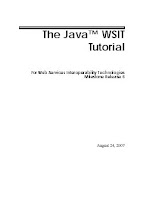What is WSIT?
Sun is working closely with Microsoft to ensure interoperability of web services enterprise technologies such as message optimization, reliable messaging, and security. The initial release of WSIT is a product of this joint effort. WSIT is an implementation of a number of open web services specifications to support enterprise features. In addition to message optimization, reliable messaging, and security,WSIT includes a bootstrapping and configuration technology. Figure 1– 1 shows the underlying services that were implemented for each technology.
Introduction
This tutorial describes how to use the Web Services Interoperability Technologies (WSIT) - a product of Sun Microsystems web services interoperability effort to develop Java clients and service providers that interoperate with Microsoft .NET 3.0 clients and service providers.
The tutorial consists of the following chapters:
• This chapter, the introduction, introduces WSIT, highlights the features of each WSIT technology, describes the standards that WSIT implements for each technology, and provides high-level descriptions of how each technology works.
• Chapter 2 provides instructions for creating, deploying, and testing Web service providers and clients using NetBeans IDE.
• Chapter 3 describes how to create a WSIT client from a Web Service Description Language (WSDL) file.
• Chapter 4 describes how to configure web service providers and clients to use message optimization.
• Chapter 5 describes how to configure web service providers and clients to use reliable messaging.
• Chapter 6 describes how to use the NetBeans IDE to configure web service providers and clients to use web services security.
• Chapter 7 provides code examples and instructions for creating, deploying, and testing web service providers and clients using either of the supported web containers.
• Chapter 8 describes how to build and run a Microsoft Windows Communication Foundation (WCF) client that accesses the addnumbers service described in Chapter 7.
• Chapter 9 describes the best practices for production and consumption of data contracts for interoperability between WCF web services and Java web service clients or Java web services and WCF web service clients.
• Chapter 10 describes Atomic Transactions.
Filetype : pdf
August 24, 2007
Download this Books
Sun is working closely with Microsoft to ensure interoperability of web services enterprise technologies such as message optimization, reliable messaging, and security. The initial release of WSIT is a product of this joint effort. WSIT is an implementation of a number of open web services specifications to support enterprise features. In addition to message optimization, reliable messaging, and security,WSIT includes a bootstrapping and configuration technology. Figure 1– 1 shows the underlying services that were implemented for each technology.
Introduction
This tutorial describes how to use the Web Services Interoperability Technologies (WSIT) - a product of Sun Microsystems web services interoperability effort to develop Java clients and service providers that interoperate with Microsoft .NET 3.0 clients and service providers.
The tutorial consists of the following chapters:
• This chapter, the introduction, introduces WSIT, highlights the features of each WSIT technology, describes the standards that WSIT implements for each technology, and provides high-level descriptions of how each technology works.
• Chapter 2 provides instructions for creating, deploying, and testing Web service providers and clients using NetBeans IDE.
• Chapter 3 describes how to create a WSIT client from a Web Service Description Language (WSDL) file.
• Chapter 4 describes how to configure web service providers and clients to use message optimization.
• Chapter 5 describes how to configure web service providers and clients to use reliable messaging.
• Chapter 6 describes how to use the NetBeans IDE to configure web service providers and clients to use web services security.
• Chapter 7 provides code examples and instructions for creating, deploying, and testing web service providers and clients using either of the supported web containers.
• Chapter 8 describes how to build and run a Microsoft Windows Communication Foundation (WCF) client that accesses the addnumbers service described in Chapter 7.
• Chapter 9 describes the best practices for production and consumption of data contracts for interoperability between WCF web services and Java web service clients or Java web services and WCF web service clients.
• Chapter 10 describes Atomic Transactions.
Filetype : pdf
August 24, 2007
Download this Books




0 comments:
Post a Comment